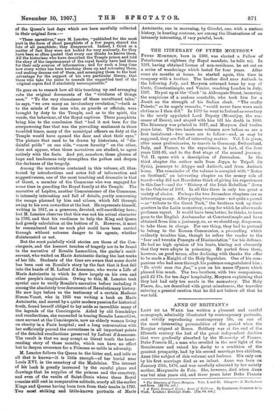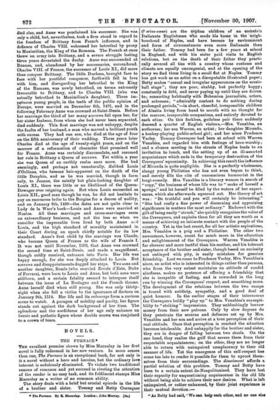ANNE OF BRITTANY. f
LADY DE LA WARR has written a pleasant and careful monograph, admirably illustrated by contemporary portraits, and vividly reproducing contemporary life, on one of the most interesting personalities of the period when the Borgias reigned at Rome. Brittany was at the end of the fifteenth century the last of the great independent duchies that were gradually absorbed by the Monarchy of France. Duke Francis II., a man who revelled in the new light of the Renaissance and raised his duchy to a condition of the greatest prosperity, had by his second marriage two children, Anne (the subject of this volume) and Isabeau. His only son by his first marriage died as an infant. Anne was born on January 25th, 1476, and was carefully educated by her saintly mother, Marguerite de Foix. She, however, died when Anne was but nine years old, and three years later Duke Francis • The Itinerary of Fynes Moryson. Vols. I. and II. Glasgow ; J. MacLehose and Sons. beet 10e. net.] t A Twice Crowned Queen: Anne of Brittany. By Constance, Countess de la Wass. London: E'relolgh Nash. [71s. 6d. net.] died also, and Anne was proclaimed his successor. She was only a child, but, nevertheless, took a firm stand in regard to the freedom of Brittany from French influence, and in defiance of Charles VIII. welcomed her betrothal by proxy to Maximilian, the King of the Romans. The French at once threw an army into Brittany, and a severe struggle lasting three years devastated the duchy. Anne was surrounded at Rennes, and, abandoned by her mercenaries, surrendered. Charles VIII. of France, the successor of Louis XI., did more thin conquer Brittany. The little Duchess, brought face to face with her youthful conqueror, forthwith fell in love with him, and disregarding her betrothal to the King of the Romans, was newly betrothed, on terms extremely favourable to Brittany, and to Charles VIII. (who was actually betrothed to Maximilian's daughter). These im- petuous young people, in the teeth of the public opinion of Europe, were married on December 6th, 1491, and in the following February Anne was crowned at Saint-Denis. Before her marriage the third of her many sorrows fell upon her, for her sister Isabeau, from whom she had never been separated, died suddenly. This first marriage was not unhappy, despite the faults of her husband, a man who marred a brilliant youth with excess. They had one son, who died at the age of four on-the fifth anniversary of their wedding. Three years later Charles died at the age of twenty-eight years, and on the morrow of a reformation of character that promised well for France. Anne was certainly disconsolate, and resumed her rule in Brittany a Queen of sorrows. Yet within a year she was Queen of an earthly realm once more. She had seemingly, and perhaps not unnaturally, disliked Louis &Orleans, who became heir-apparent on the death of the little Dauphin, and as he was married, though in form only, to Jeanne, the saintly but plain-looking daughter of Louis XI., there was little or no likelihood of the Queen- Dowager ever reigning again. But when Louis succeeded as Louis XII., good man though be was, be did not hesitate to pay an enormous bribe to the Borgias for a decree of nullity, and on January 8th, 1499—the dates are not quite clear in Lady de la Warr's book—Louis and Anne were married at Nantes. All these marriages and cross-marriages seem an extraordinary business, and not the less so when we consider the impeccable lives lived by both Anne aed Louis, and the high standard of morality maintained in their Court during an epoch chiefly notable for its low standard. Anne's first child by the marriage was Claude, , who became Queen of France as the wife of Francis I. It was not until November, 1503, that Anne was crowned the second time at Saint-Denis, and made a magnificent, though coldly received, entrance into Paris. Her life was happy enough, for she was deeply attached to Louis. But sorrows and disappointments dogged her steps. Two sons and another daughter, Renee (who married Ercole d'Este, Duke of Ferrara), were born to Louis and Anue, but both SODS were stillborn, and a certain fatality seemed to interpose itself between the issue of La Bretagne and the French throne. Anne herself died when still young. She was only thirty- eight when she fell a victim to the ignorance of doctors on January 9th, 1514. Her life and its entourage form a curious scene to watch. A paragon of nobility and purity, her figure stands out against the dark background of her time. The splendour and the sordidness of her age only enhance an heroic and pathetic figure whose double crown was conjoined to a crown of tears.



















































 Previous page
Previous page